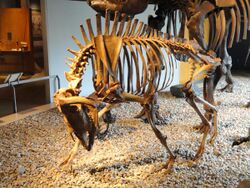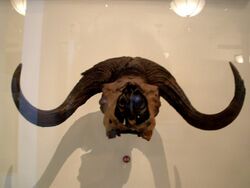Biology:Bootherium
| Bootherium | |
|---|---|

| |
| Scientific classification | |
| Domain: | Eukaryota |
| Kingdom: | Animalia |
| Phylum: | Chordata |
| Class: | Mammalia |
| Order: | Artiodactyla |
| Family: | Bovidae |
| Subfamily: | Caprinae |
| Tribe: | Ovibovini |
| Genus: | †Bootherium Leidy, 1852 |
| Species: | †B. bombifrons
|
| Binomial name | |
| †Bootherium bombifrons (Harlan, 1825)
| |
| Synonyms | |
|
Symbos cavifrons | |
Bootherium (Greek: "ox" (boos), "beast" (therion)[1]) is an extinct bovid genus from the middle to late Pleistocene of North America which contains a single species, Bootherium bombifrons.[2] Vernacular names for Bootherium include Harlan's muskox, woodox, woodland muskox,[3] helmeted muskox,[4] or bonnet-headed muskox.[5] Bootherium was one of the most widely distributed muskox species in North America during the Pleistocene era. It is most closely related to the modern muskox, from which it diverged around 3 million years ago,[6] it is possibly synonymous with Euceratherium, although this is uncertain.[7]
Taxonomy
Fossils have been documented from as far north as Alaska to California , Utah,[8] Texas , Missouri, Michigan,[9] Oklahoma, Virginia, North Carolina and New Jersey. The species became extinct approximately 11,000 years ago at the end of the last ice age.[3]

Symbos was formerly thought to be a separate genus, but is now known to be synonymous.[10] The closest relative of Bootherium is the extant muskox Ovibos moschatus. However, unlike the tundra muskox, Bootherium was physically adapted to a range of less frigid climates and appears to have been the only ox to have evolved in and remain restricted to the North American continent.[3] Bootherium was significantly taller and leaner than muskoxen found today in Arctic regions. Bootherium were estimated to weigh around 423.5 kg (934 lb).[11] Other differences were a thicker skull and considerably longer snout. The horns of Bootherium were situated high on the skull, with a downward curve and were fused along the midline of the skull, unlike tundra muskoxen whose horns are separated by a medial groove.
Three other species of musk oxen co-inhabited North America during the Pleistocene era. Besides the surviving tundra muskox, the extinct shrub-ox (Euceratherium collinum) and Soergel's ox (Soergelia mayfieldi) were also present.
Notes
- ↑ "Glossary. American Museum of Natural History". https://research.amnh.org/paleontology/perissodactyl/concepts/glossary.
- ↑ McKenna & Bell, 1997, p. 442.
- ↑ 3.0 3.1 3.2 The Academy of Natural Sciences
- ↑ Helmeted Muskox (Bootherium bombifrons) from Near Fort Saskatchewan, Alberta: Dating Evidence for Redeposition in Late Pleistocene Alluvium
- ↑ Martin, Paul S. (1999). "War Zones and Game Sinks in Lewis and Clark's West". Conservation Biology 13: 36–45. doi:10.1046/j.1523-1739.1999.97417.x.
- ↑ West, Abagael Rosemary (January 2016). "Mitogenome of the extinct helmeted musk ox, Bootherium bombifrons". Mitochondrial DNA Part B 1 (1): 862–863. doi:10.1080/23802359.2016.1250136. ISSN 2380-2359. PMID 33473657.
- ↑ Bover, Pere; Llamas, Bastien; Thomson, Vicki A.; Pons, Joan; Cooper, Alan; Mitchell, Kieren J. (December 2018). "Molecular resolution to a morphological controversy: The case of North American fossil muskoxen Bootherium and Symbos" (in en). Molecular Phylogenetics and Evolution 129: 70–76. doi:10.1016/j.ympev.2018.08.008. PMID 30121342.
- ↑ http://giw.utahgeology.org/giw/index.php/GIW/article/download/17/24/ [bare URL PDF]
- ↑ Abraczinskas, L. M.. "Pleistocene proboscidean sites in Michigan: New records and an update on published sites.". Michigan Academian 25 (4): 443–490.
- ↑ McDonald, Jerry N.; Ray, Ray, Clayton E. (1989). "Autochthonous North American Musk Oxen Bootherium, Symbos, and Gidleya (Mammalia: Artiodactyla: Bovidae)". Smithsonian Contributions to Paleobiology (66): 1–77. doi:10.5479/si.00810266.66.1. ISSN 0081-0266. https://www.biodiversitylibrary.org/itempdf/266430.
- ↑ Paleobiology Database: Bootherium bombifrons
References
- McKenna, Malcolm C.; Bell, Susan K. (1997). Classification of Mammals Above the Species Level. ISBN 978-0-231-11013-6.
External links
- http://nature.ca/notebooks/english/helmet.htm
- https://web.archive.org/web/20080407140851/http://www.ansp.org/museum/jefferson/otherFossils/bootherium.php
Wikidata ☰ {{{from}}} entry

